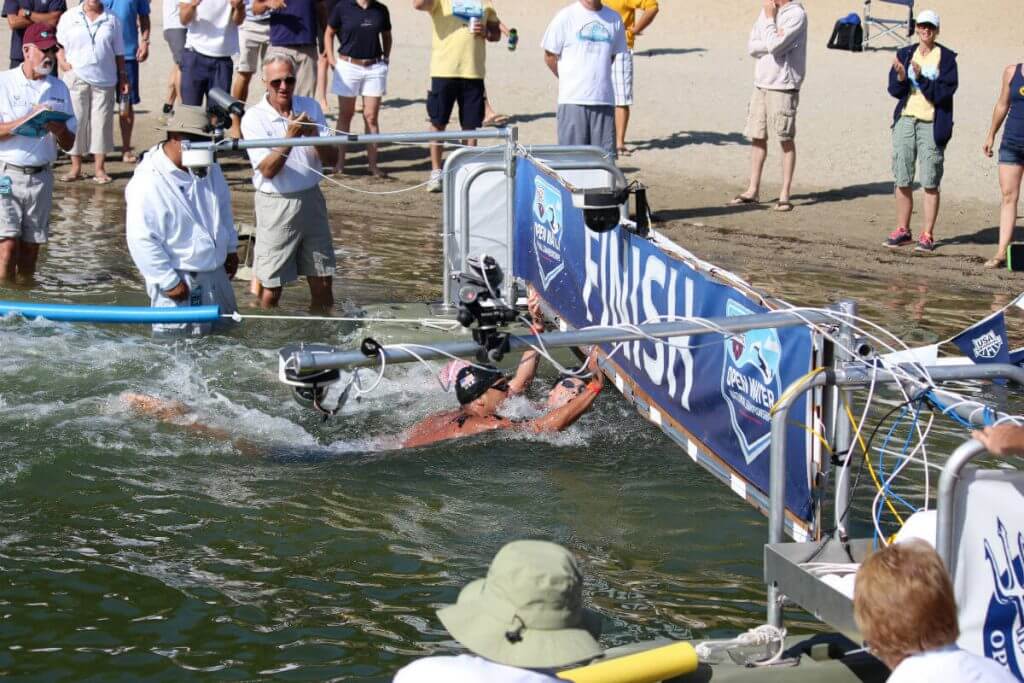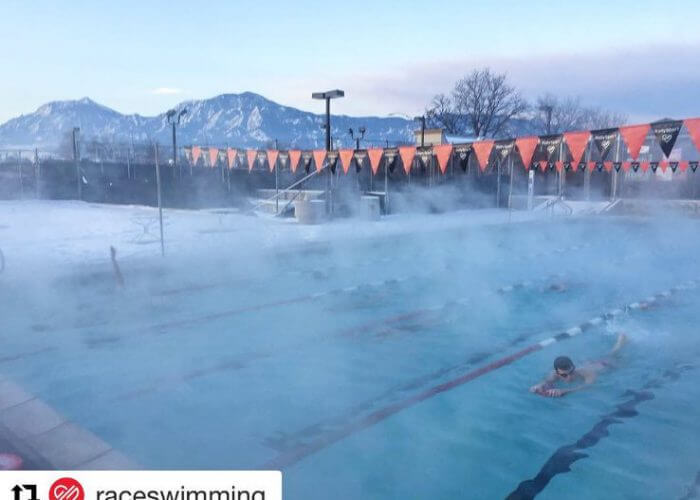Open Water Training with Grant Holicky

by Robbie Dickson, Swimming World College Intern.
Grant Holicky, head coach of Rallysport Aquatics (RACE) in Boulder, Colorado, has been working with elite open water swimmers for several years now. Two of his most notable athletes are Joey Pedraza, who finished third in the 5k at the 2014 Nationals, and Christine Jennings, who has been to both World Championships and the Pan Pacific Championships for open water.
With all this success, plus the success that Coach Holicky has with his pool swimmers, you would assume that he has some of the best facilities in the country. However, that couldn’t be further from the truth, RallySport Aquatics practice in a six lane, hotel pool. Oh and it is outside the ENTIRE year. In Colorado. That makes for some very cold morning practices.

Photo Courtesy: RaceSwimming
I interviewed Coach Holicky about open water training as well as where he sees the sport developing over the next four years.
RD: How, if at all, does training differ from training a miler than a 5 or 10k swimmer?
GH: I think the training differs significantly. Milers need to be able to hold a very high pace and rate for 15 min or so. The training needs to built around that as a goal. Open water 5 and 10k swimmers are faced with a very different race environment. They need to be able to change speeds very quickly and respond to other peoples surges and sometimes slowdowns. The swimmer who can find their rhythm in slow pace and immediately jump to full speed with have success.
RD: Do Open Water swimmers require a different dry-land training from their pool teammates?
GH: Many of the dry lands needs have overlap, but we have always enjoyed a little cross training for open water. With the increased athleticism, our athletes are able to respond to when the are bumped and pushed. The physical nature of Open Water is a very different element from the pool.
RD: Some critical parts of an Open Water race are feeding and finishing, how do you prepare your swimmers for that?
GH: We practice feeding a good bit. We’ll have the feed-stick during workout and mid repeat ask them to come in and take a feed. This works well as it simulates the chaos around them. We also ask them drink all of what we give them. Drinking 8 oz at once is not the way we ideally would fuel our body and you have to get used to it so that you don’t lose the feed.
We replicate the finish in a couple different ways. The speed change work and the high end speed work we do in workout will simulate this for sure. However, we will also finish swims without a turn on the last length and have a sprint to the last wall. Other times we will create a finishing mat and have them finish swims to that mat.
RD: How does a swimmer get ready for the bumping and jostling that takes place throughout the race?
GH: The physical nature of the sport is so different and simply being touched is what many swimmers dislike as they come to open water. We often will have three swimmers share a lane and leave at the same time and ask them to swim the same speed and our lanes are not big. Other times two swimmers will split a lane and we ask them to initiate contact with the other swimmer once each lap.
RD: What are the final days before a Nationals like from a training standpoint?
GH: The final days before a big competition often have similarities to a pool taper. We tend to keep the volume higher by still doubling early in the week and doing two 3k workouts as late as Thursday or Friday. Several of my open water swimmers are post grads and a bit older, so they’re volume comes down a bit more than the younger ones. There are workouts that specifically contain speed work to prime the engine. In the final days at the venue we will get out in the venue and practice what the buoys are like and study the sight lines to them and the finish structure.
RD: Is it possible to be a good Open Water swimmer without access to a lake, river, or ocean?
GH: I think so. The year Christine won Nationals, our first non-pool swim (other than competitions) of the year was at the venue two days before the race. You do have to modify the workouts and the conditions to prep your swimmers though.
RD: How would you like to see U.S. Open Water Swimming develop over the next four years?
GH: We have a strong program and a good support system to get swimmers to the World Cups and that experience has really shown in our swimmers at the International level. It is hard to get that experience without those competitions though. Our domestic races aren’t quite deep enough to create the pack swimming feel and stress. Additionally, many coaches feel that open water will hurt their distance swimmer’s performance in the pool and avoid the races that may interfere with nationals prep. We need Sectional and State championship open water races that introduce the sport to a younger population. This way they hit Nationals and International competitions with knowledge and are not overwhelmed. I feel as if we lose too many great swimmers because their first experience in the open water is overwhelming. We are doing a good job at the top, but are struggling to develop new talent to fill the shoes of our very best as they retire.
RD: How do you prepare your athletes mentally for swimming two hours straight?
GH: We will often have our guys get in and do straight swims. Often they are 60 min but at times longer. No clock, no pacing, just swim. As much times as our athletes spend in the water, that is not something they do.
RD: When arriving at the venue, what is the general routine for your athletes pre-race?
GH: Each athlete’s pre race routine is unique. To assume that I can create that for them is in my opinion narrow minded. I encourage my athletes to lay that plan out ahead of time and go through potential pitfalls with them. I do know their routines and therefore at the venue can keep them on track and provide support to help do just that.
All commentaries are the opinion of the author and do not necessarily reflect the views of Swimming World Magazine nor its staff.



